Are you finding it hard to scale your link outreach efforts without your emails ending up ignored or marked as spam? In this article, we will show you 10 proven strategies to expand your link building efforts while keeping each link credible and relevant.
By the end of this read, you will know how to attract high-quality links that boost your SEO and drive conversion-focused traffic to your site.
10 Steps To Scale Your Link Outreach Without Losing Quality
These 10 steps will guide you through a streamlined approach to building a strong backlink profile. Pay close attention to step 5, where we reveal how automation tools can make your outreach more efficient and impactful.
Step 1: Choose Your Link Building Outreach Strategy
This step shapes how you identify and approach potential link sources. Your tactic determines what kind of content to create and how to pitch it to potential linking partners. Here are 7 proven outreach strategies to diversify your link building efforts and acquire quality backlinks:
1.1 Guest Posting
- What It Is: Writing articles for other websites in exchange for a backlink to your site.
- How To Do It: Find websites in your niche that accept guest posts. Look for sections like “Write for Us” or contact site owners directly. Pitch a topic that aligns with their audience. Once accepted, write a well-researched blog post and include a link to your site naturally within the content. Make sure the link provides value and isn’t forced.
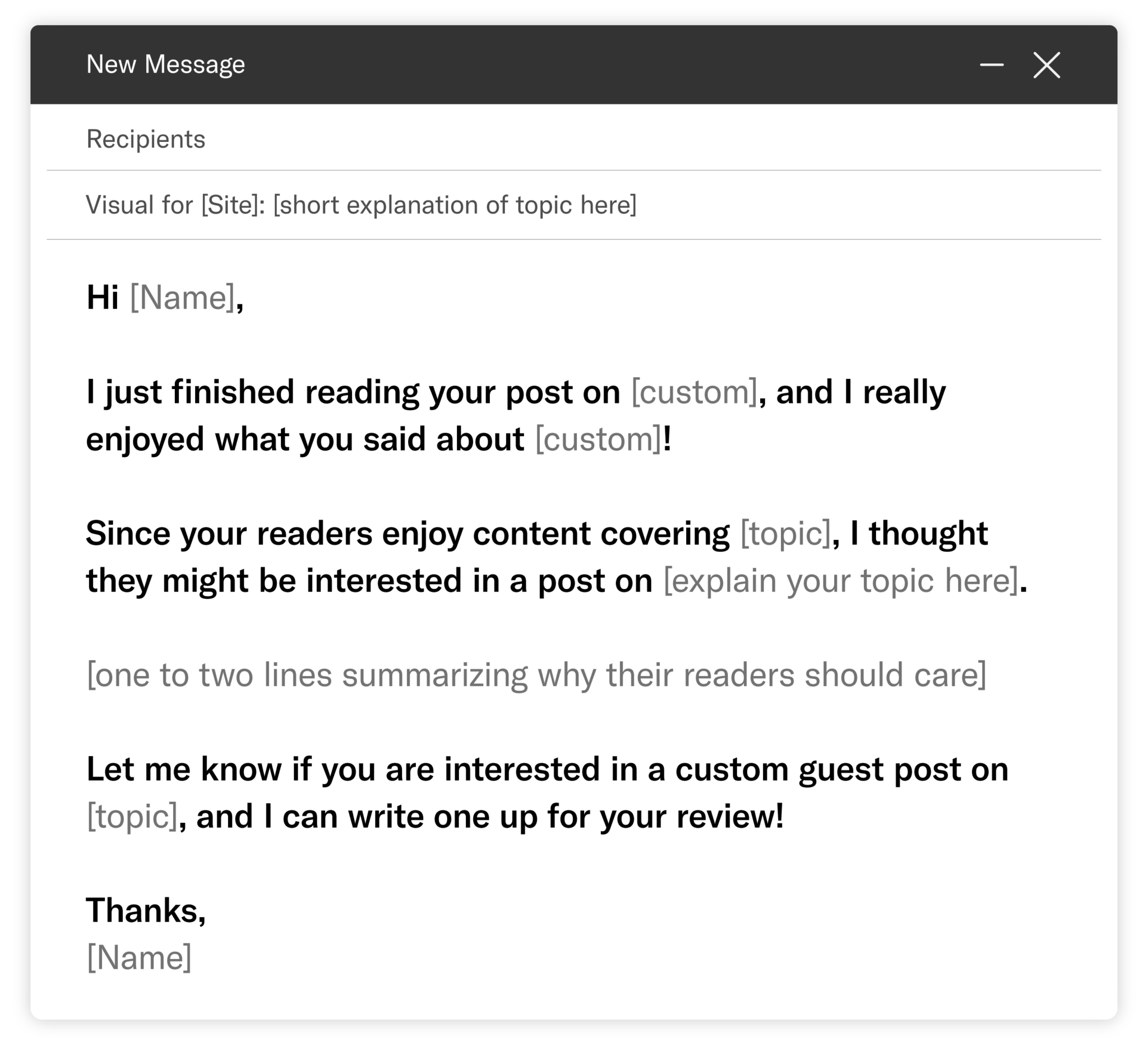
1.2 Resource Page Outreach
- What It Is: Asking websites with “Resources” or “Helpful Links” pages to include your content as a reference.
- How To Do It: Search Google for phrases like “[your niche] + resources.” Review their resource page to see if your content fits. If it does, contact the site owner with a short, polite email, explaining why your content would be a valuable addition. Mention how your guide, tool, or article can benefit their readers.
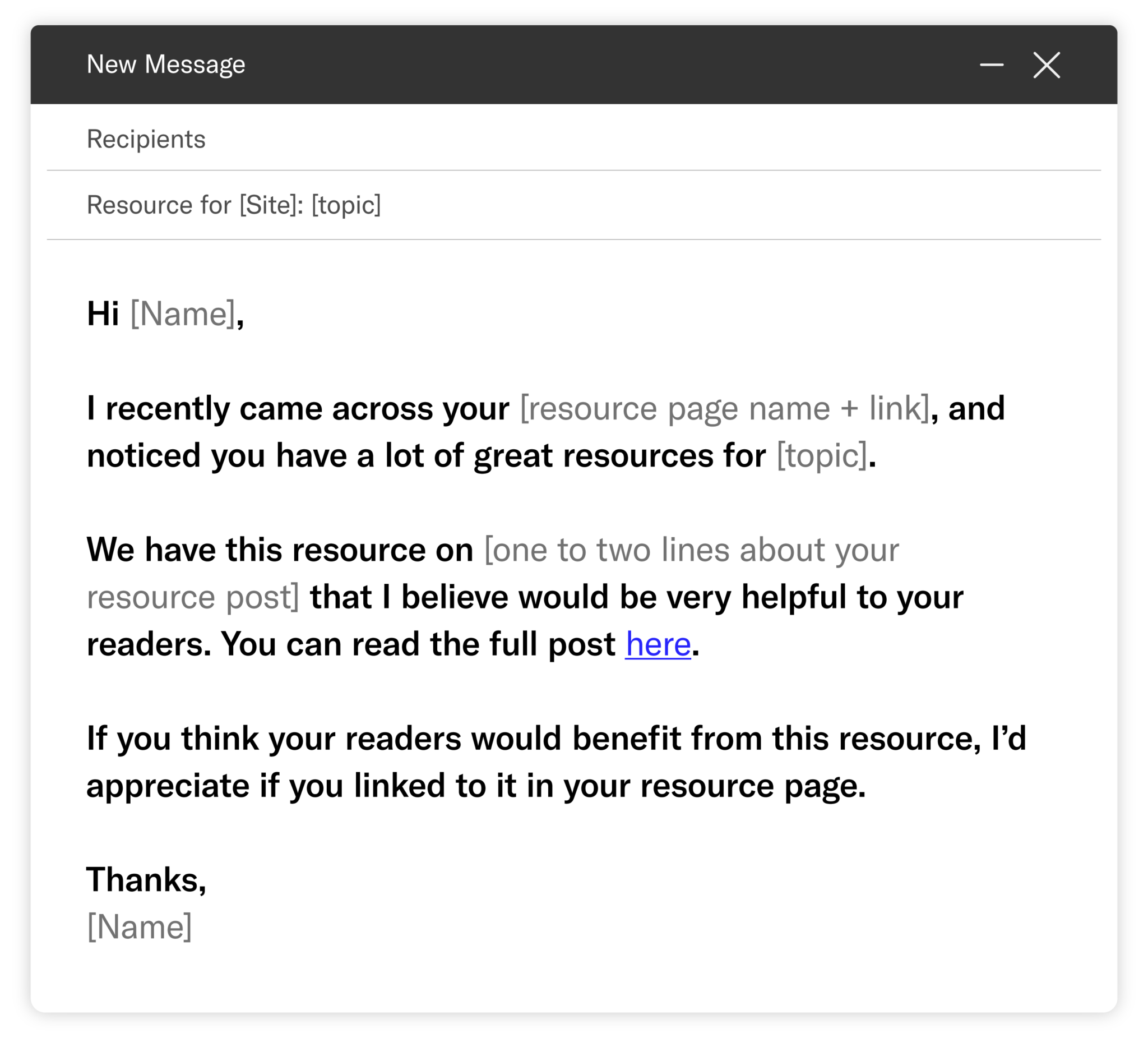
1.3 Broken Link Building
- What It Is: Replacing broken links on other websites with links to your relevant content.
- How To Do It: Use Ahrefs Broken Link Checker or the Check My Links browser extension to identify broken links on websites in your niche. Once you find a broken link, contact the website owner, let them know about the issue, and suggest your content as a replacement. Make it easy for them by providing the exact URL of the broken link.
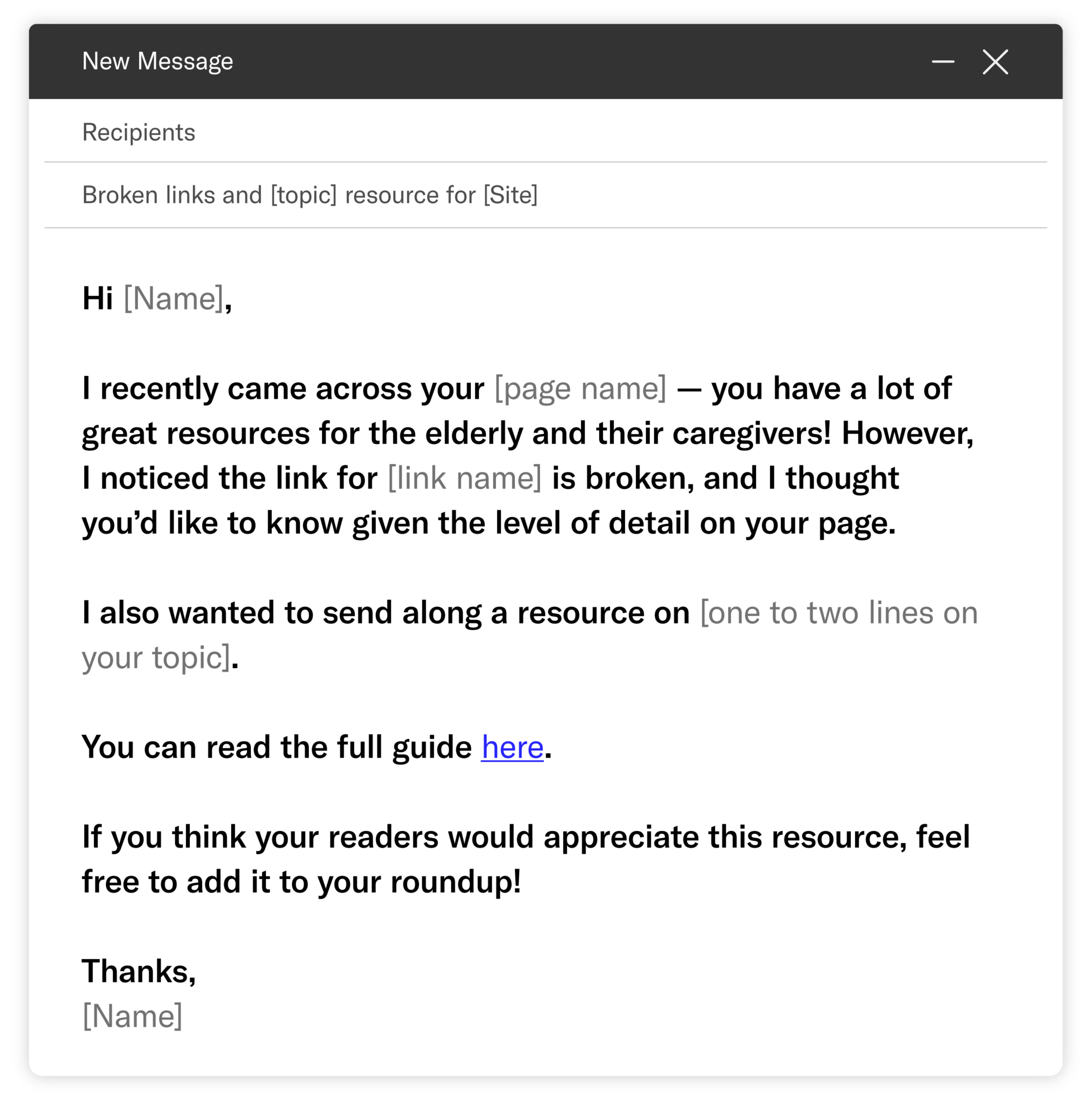
1.4 Skyscraper Technique
- What It Is: Creating a better version of popular content and asking websites to link to it.
- How To Do It: Find high-performing articles in your niche using Ahrefs’s Content Explorer. Create a more detailed, up-to-date, and visually appealing version of that content. Then, use Ahrefs’ Site Explorer with the “Backlinks” feature to identify websites linking to the original article. Contact these sites and suggest linking to your improved version, explaining how it offers more value.
1.5 Link Insertions (Existing Content)
- What It Is: Asking site owners to include a link to your content within their existing articles.
- How To Do It: Identify relevant articles on other websites that would benefit from your content. Contact the site owner with a brief, personalized email. Point out a specific section in their article where your link would fit naturally and explain how it adds value for their readers.
1.6 Mention Outreach
- What It Is: Requesting a backlink when someone mentions your brand but doesn’t link to your site.
- How To Do It: Use Google Alerts or Ahrefs to track brand mentions. When you find a mention without a link, contact the site owner. Politely ask if they could include a link to your site, explaining that it helps provide more context for their readers.
1.7 Collaboration and Partnerships
- What It Is: Working with influencers, bloggers, or companies for joint content that includes backlinks.
- How To Do It: Engage with influencers and bloggers in your niche through social media, comments, or email. Propose collaboration ideas like interviews, co-authored blog posts, or product reviews. Make sure the collaboration naturally includes links to your website and aligns with their audience’s interests.
Step 2: Research & List High-Quality Prospects
Identify potential websites that align with your niche and have a strong domain authority (40+). Here’s how to make this process effective and thorough:
2.1 Use SEO Tools To Find Quality Sites
Use Ahrefs, SEMrush, and Moz to search for high-quality prospects. Look for sites with:
- A Domain Authority (DA) of 40+.
- A low spam score (preferably below 10%).
- Significant organic traffic (ex. more than 1,000 monthly visits).
Use these tools to identify websites linking to your competitors. This method gives you a list of sites that are already interested in linking to similar content.
2.2 Filter By Niche Relevance
Refine your search to include websites and blogs that are directly related to your industry. For example, if your content focuses on health and wellness, target brands like Green Supply or MindBodyGreen that feature organic products. This approach ensures your backlinks are relevant and connects you with an audience already invested in wellness.
2.3 Use Content Gap Analysis
In Ahrefs, for example, use the “Content Gap” tool. Enter the URLs of your top competitors to see which keywords they rank for across search engines. In the “Link Intersect” feature, input competitor domains to identify websites that link to them but not to you.
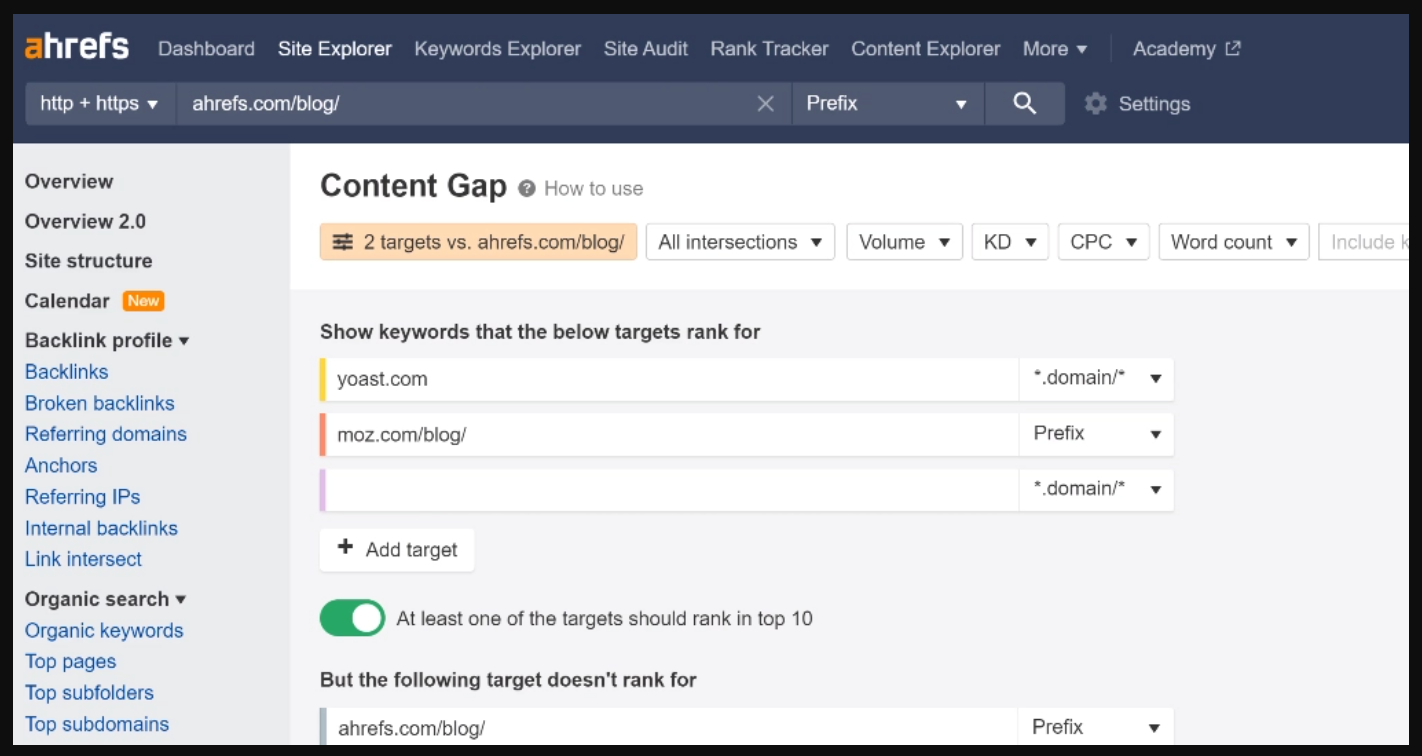
Step 3: Segment Prospects Into Tiers
Create 3 main segments: High-Tier, Medium-Tier, and Low-Tier. Each segment will have different outreach strategies tailored to their relevance and authority level.
3.1 High-Tier Prospects
- Criteria:
- DA of 60+
- Strong relevance to your niche
- High organic traffic (5,000+ monthly visitors)
- High-quality, in-depth content
- Outreach Focus: These are your top priorities. Approach them with highly personalized emails and offer them your best, most valuable content. Highlight how linking to your resource will add value to their audience.
- Examples: Established industry blogs, authoritative news websites, and niche leaders like HubSpot or Moz.
3.2 Medium-Tier Prospects
- Criteria:
- DA of 30–60
- Moderate relevance to your niche
- Medium organic traffic (1,000–5,000 monthly visitors)
- Decent content quality
- Outreach Focus: These prospects are valuable but not as competitive. Use semi-personalized emails, referencing their recent content or niche. Offer content that aligns with their site’s general topics and audience interests.
- Examples: Niche-specific blogs, mid-sized industry publications, and emerging thought leader websites.
3.3 Low-Tier Prospects
- Criteria:
- DA below 30
- Basic relevance to your niche
- Low organic traffic (below 1,000 monthly visitors)
- Varying content quality
- Outreach Focus: While these prospects may have less SEO value individually, they can still help diversify your backlink profile. Use a more general outreach approach, offering your content as a helpful resource for their readers.
- Examples: Small niche blogs, newer websites, and personal blogs with relevant content.
Step 4: Organize Your Segmented Prospect List
Use a spreadsheet (ex. Excel, or Google Sheets) to organize and categorize your prospects. Include columns for:
- Website Name
- URL
- Domain Authority (DA)
- Monthly Organic Traffic
- Relevance Score (ex. High, Medium, Low)
- Segmentation Tier (High, Medium, Low)
- Notes on Personalization (ex. “Mention their article on SEO strategies”)link outreach
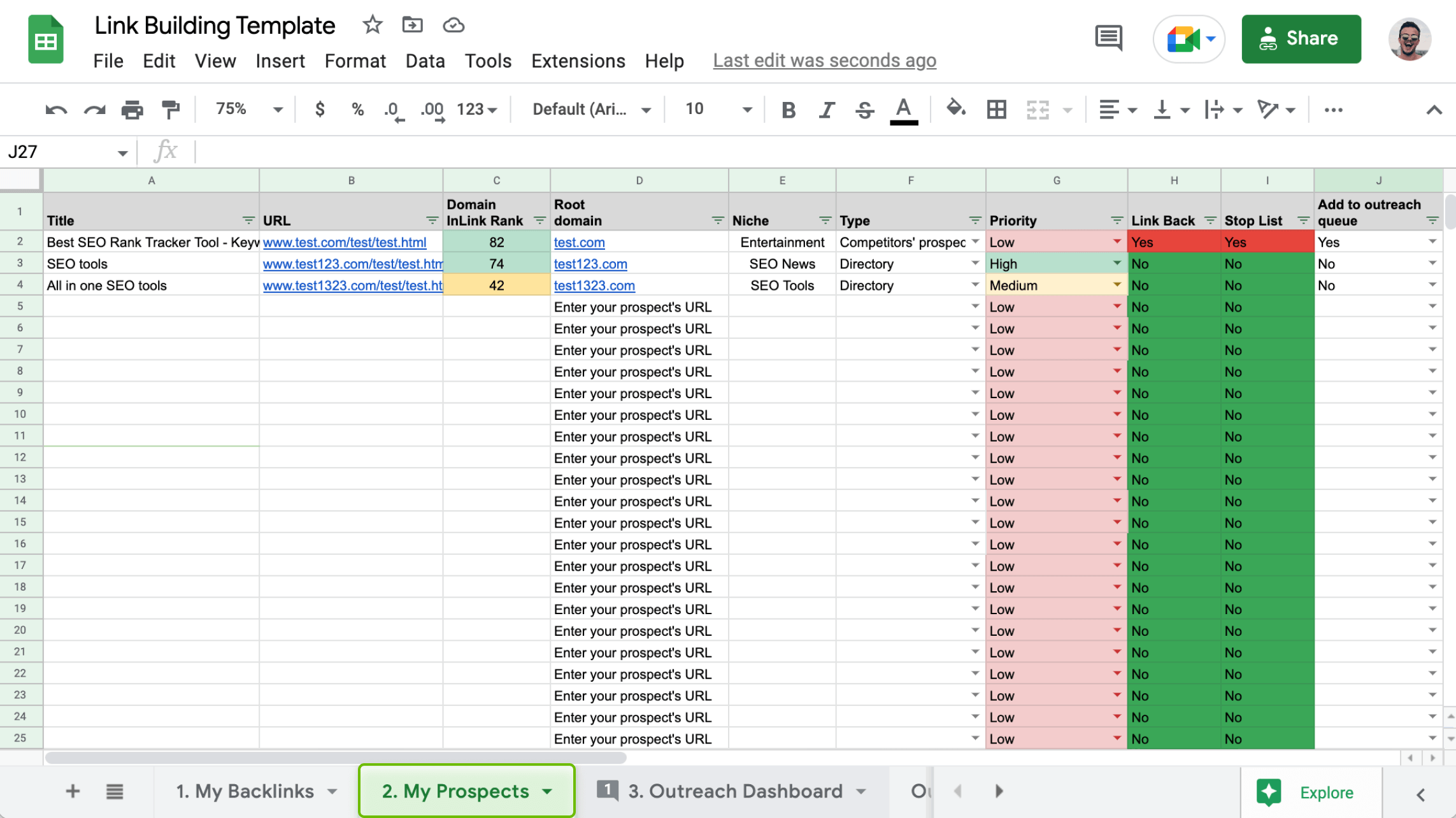
Step 5: Develop High-Quality, Link-Worthy Content
Create a well-rounded content bank filled with high-value, evergreen, and tailored pieces. Here’s how to create an effective content bank:
5.1 Create Long-Form Guides
Write comprehensive guides, how-to articles, and ultimate resource lists in your niche. Aim for 2,000+ words, packed with actionable insights, practical examples, and data-backed points. For example, a digital marketing agency can create an “Ultimate Guide to SEO in 2024.”
5.2 Conduct Original Research
Publish data-driven content like surveys, case studies, or industry reports. Original research adds unique value, making it more attractive to others who want to cite credible data.
5.3 Include Visual Assets
Design infographics, charts, and data visualizations to complement your articles. Visual content increases shareability and provides a ready-made resource for other websites to reference.
5.4 Prioritize Evergreen Content
Develop articles, guides, and lists that stay relevant over time, such as “Top 10 Digital Marketing Tools.” Evergreen content has a longer shelf life, giving you more time to use it for link outreach.
5.5 Regularly Update
Keep this content up-to-date. Websites are more likely to link to current, reliable resources. Set a quarterly schedule to refresh statistics, facts, and examples in your content bank.
5.6 Curate Resources For Different Niches
Diversify your content bank to cater to various websites in your outreach. For example, if you are in the fitness industry, include articles on “Nutrition Tips,” “Workout Routines,” and “Mental Health for Athletes.”
5.7 Offer Exclusive Content
Prepare unique content offers like a guest post, interview, or whitepaper. When you approach a prospect, offer them an exclusive piece tailored to their audience’s interests. For example, if you are reaching out to a health blog, pitch them an exclusive article titled “The Science Behind High-Intensity Interval Training.”
5.8 Organize Your Content Bank For Easy Access
Use a spreadsheet to list all your content pieces like:
- Title: “The Ultimate SEO Guide”
- URL: [Link to Content]
- Type: Guide
- Target Audience: Marketing blogs
- Last Updated: June 2024
Step 6: Automate Initial Outreach & Set Up Follow-Up Sequences
Use a link building outreach tool and set up follow-up sequences to ensure timely and consistent communication with prospects. For example, Pitchbox, BuzzStream, and Mailshake let you send bulk emails while incorporating personalized elements.
Once you select your tool, upload your segmented prospect list (organized earlier) to your chosen tool. Make sure the list includes key personalization fields like names, website URLs, and notes for customized messages. Follow the 7 steps to make sure your outreach emails are effective:
- Set Up Campaigns: Create a separate link building outreach campaign within the tool for each prospect tier (High, Medium, Low). This lets you customize the messaging based on the importance level and relationship-building required.
- Design Email Templates: Write templates for the initial emails for each tier. Use dynamic fields (ex. [Prospect’s Name], [Website Name]) to automate personalization in the emails.
- Schedule Follow-Up Emails: Create follow-up sequences for each tier within the tool. For high-tier prospects, schedule the first follow-up about 5–7 days after the initial email. For medium and low-tier prospects, a 7–10 day gap works well.
- Craft Follow-Up Templates: Write brief follow-up templates that politely remind the recipient of your previous email and reiterate the value of your content. Keep them short, friendly, and non-pushy. For example, “Hi [Prospect’s Name], just wanted to check if you had a chance to look at the resource I shared on [Your Content Topic]. I’d love to hear your thoughts!”
- Add Custom Snippets: For high-tier prospects, create custom snippets that you can add manually before sending. For example, include a specific compliment about their recent work or mention how your content aligns with their audience’s needs.
- Flag High-Interest Responses: Set up automated alerts within the tool to notify you when a prospect responds positively. This lets you step in and handle these conversations manually, ensuring you address any questions or opportunities with a personal touch.
- Add To CRM: For high-potential prospects, add them to your CRM for ongoing relationship-building. This step forms long-term partnerships with authoritative websites.
Step 7: Personalize The First 2 Sentences Of Each Email
To grab a prospect’s attention, personalize the first 2 sentences of each outreach email. Start by visiting their website or blog and find a recent article or piece of content that aligns with your niche. Identify specific elements like the title, a unique perspective, or a particular quote they used. This initial research shows you’ve taken the time to understand their work.
Next, mention this specific content in your introduction. For example: “Hi [Prospect’s Name], I just read your article on ‘Effective Email Marketing,’ and I found your insights on subject line testing particularly valuable!” This instantly sets a personalized tone.
Then, smoothly transition into your pitch by connecting their content to yours. For example, “It got me thinking about a resource I recently put together on [Your Content Topic], which complements your discussion.”
If it’s a high-tier prospect, reference a more detailed aspect, such as a case study or data point they used, to make your email stand out.
Keep a library of personalization snippets to streamline your link building outreach process. Maintain a spreadsheet or document where you store your personalized notes for each prospect. Include fields like:
- Prospect Name
- Recent Article/Content
- Specific Point/Quote to Mention
- Connection to Your Content
This shows you value their work and increases the chance of getting a positive response.
Step 8: Create A Quality Control Checklist
A quality control checklist helps maintain high standards during link outreach. It ensures you are building links from credible and relevant websites. Here’s a comprehensive checklist to use before reaching out to prospects:
- DA/DR Score: Check the website’s Domain Authority using tools like Ahrefs, Moz, or SEMrush. Aim for a DA of 30+ for general outreach, and 50+ for high-tier prospects.
- Monthly Organic Traffic: Use Ahrefs or SEMrush to confirm the website has a steady flow of 1,000+ monthly organic visitors. Higher traffic often indicates an active audience and better link value.
- Topic Alignment: Ensure the website regularly publishes content related to your niche. Review their recent articles to see if your content fits their themes.
- Audience Match: Verify that the website’s audience aligns with your target audience to maximize link impact.
- In-Depth & Updated Content: Check if the site publishes well-researched, in-depth articles that are updated regularly.
- Visual Elements: Look for high-quality images, infographics, or charts within their content, as it shows their commitment to creating engaging resources.
- User Engagement: Check for active user engagement–comments, social shares, and discussions. A high level of interaction often signals a reputable site.
- Professional Design: Ensure the site has a clean, professional design with easy navigation. Avoid websites cluttered with excessive ads or pop-ups.
- Mobile-Friendly: Confirm the site is mobile-responsive by testing its layout on mobile devices or using Google’s Mobile-Friendly Test.
- Check Existing Outbound Links: Review the website’s existing outbound links. If they link to spammy or irrelevant sites, consider avoiding outreach to maintain your backlink quality.
- Low Spam Score: Use Moz’s Spam Score tool to verify the website has a spam score of under 10%. High spam scores could negatively impact your SEO.
- Healthy Backlink Profile: Check the site’s backlink profile using Ahrefs or SEMrush. Ensure it has a mix of links from reputable sources rather than an unnatural concentration of low-quality backlinks.
- Clear Contact Details: Verify the presence of a valid contact page, with an email address or a contact form. This shows the site is legitimate and open to collaborations.
Step 9: Outsource Prospecting With Clear Guidelines
Outsourcing prospecting can save time, but you need clear guidelines to ensure your outreach stays high quality. Here’s how to set up effective outsourcing for link prospecting:
9.1 Choose The Right Freelancer Or Agency
If you need ongoing, day-to-day support that aligns closely with your brand’s evolving link building strategy, hire an in-house link building expert. This works best if you’re looking for consistent, hands-on outreach tailored to your specific goals.
However, if your goal is to rapidly scale your link building efforts, or you prefer a flexible, project-based approach, go for an agency. For example, at Linkmill, we bring access to a broad network of high-quality websites and manage the entire outreach process for you. Choose this if you are aiming for a quick boost in domain authority or want to run a targeted link building campaign without the commitment of hiring full-time staff.
9.2 Provide Detailed Prospecting Guidelines
Outline clear instructions in a document, focusing on the criteria prospects should meet. Here’s what to include:
- Domain Authority (DA)
- Organic Traffic
- Niche Relevance
- Spam Score
- Content Quality
9.3 Set Up A Prospecting Process
Share a spreadsheet template where they can list prospects. Columns should include:
- Website Name
- URL
- Domain Authority (DA)
- Organic Traffic
- Niche Relevance Score (High, Medium, Low)
- Contact Details
- Notes on Personalization Opportunities
9.4 Offer Examples Of Ideal Prospects
Share a sample list of 5–10 ideal prospects that meet your criteria. Highlight what makes these examples suitable like their DA, content quality, or niche relevance. Clarify what to avoid like sites with thin content, excessive ads, or unrelated niches.
9.5 Set Quality Checkpoints
Keep a schedule to review the prospects they find, especially during the initial phase. Offer feedback to ensure they understand and follow your guidelines.
Step 10: Track Responses & Adjust Outreach Tactics
Track responses to understand what works in your outreach and where adjustments are needed. Monitoring open rates, reply rates, and link acquisition helps optimize your tactics for better results. Here’s how to do it:
- Use Link Building Outreach Tools For Tracking: Use BuzzStream, Pitchbox, or Mailshake to track the status of your emails, including open rates, click-through rates, and responses. These tools automatically update as prospects open, click, or reply to your emails.
- Evaluate Open Rates: A low open rate might indicate that your subject line needs improvement. Experiment with subject lines that reference the recipient’s content or offer value directly, like “Loved Your Article on [Topic] – A Resource for Your Readers.”
- Review Reply Rates: If you are getting opens but not replies, consider adjusting your email’s body content. Test different opening lines, personalization strategies, or calls to action.
- A/B Test: Use A/B testing for different email templates, follow-up sequences, and subject lines. For example, try a template that directly references a specific section of the prospect’s recent article versus one that offers a value proposition.
- Refine Follow-Up Timing: Test different intervals for follow-up emails (ex. 5 days versus 7 days) to find the timing that yields best response rates.
Conclusion
Every email you send isn’t just another pitch; it’s a chance to create a mutually beneficial partnership. So, as you refine your next outreach email, ask yourself: how will this message stand out in their inbox and offer them something genuinely valuable? Thinking this way ensures your outreach is thoughtful, not spammy, and that’s where success lies.
Ready to take your link building to the next level? Check out Linkmill. We specialize in helping you secure high-quality backlinks, taking the heavy lifting out of link outreach so you can focus on what matters; growing your business. Are you prepared to make every link count?
